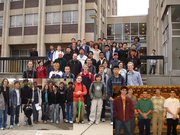06-240/Classnotes For Thursday November 9: Difference between revisions
From Drorbn
Jump to navigationJump to search
(formatted) |
No edit summary |
||
| Line 5: | Line 5: | ||
|- |
|- |
||
|'''Problem.''' Find the rank (the dimension of the image) of a linear transformation <math>T</math> whose matrix representation is the matrix A shown on the right. |
|'''Problem.''' Find the rank (the dimension of the image) of a linear transformation <math>T</math> whose matrix representation is the matrix A shown on the right. |
||
|<math>A=\begin{pmatrix}0 |
|<math>A=\begin{pmatrix}0</math> |
||
|} |
|||
{| |
|||
|- valign=bottom |
|||
|'''Theorem 1.''' If <math>T:V\to W</math> is a linear transformation and <math>P:V\to V</math> and <math>Q:W\to W</math> are ''invertible'' linear transformations, then the rank of <math>T</math> is the same as the rank of <math>QTP</math>. |
|||
| |
|||
|'''Proof.''' Owed. |
|||
|- valign=bottom |
|||
|'''Theorem 2.''' The following row/column operations can be applied to a matrix <math>A</math> by multiplying it on the left/right (respectively) by certain ''invertible'' "elementary matrices": |
|||
# Swap two rows/columns |
|||
# Multiply a row/column by a nonzero scalar. |
|||
# Add a multiple of one row/column to another row/column. |
|||
| |
|||
|'''Proof.''' Semi-owed. |
|||
|} |
|||
'''Solution of the problem.''' using these (invertible!) row/column operations we aim to bring <math>A</math> to look as close as possible to an identity matrix, hoping it will be easy to determine the rank of the matrix we get at the end: |
|||
{| border="1px" cellspadding="5" cellspacing=0 style="font-size:90%;" |
|||
|+ |
|||
|align=center|'''Do''' |
|||
|align=center|'''Get''' |
|||
|align=center|'''Do''' |
|||
|align=center|'''Get''' |
|||
|- valign=top |
|||
|1. Bring a <math>1</math> to the upper left corner by swapping the first two rows and multiplying the first row (after the swap) by <math>1/4</math>. |
|||
|align=center|<math>\begin{pmatrix}1&1&1&2&0\\0&2&4&2&2\\8&2&0&10&2\\6&3&2&9&1\end{pmatrix}</math> |
|||
|2. Add <math>(-8)</math> times the first row to the third row, in order to cancel the <math>8</math> in position 3-1. |
|||
|align=center|<math>\begin{pmatrix}1&1&1&2&0\\0&2&4&2&2\\0&-6&-8&-6&2\\6&3&2&9&1\end{pmatrix}</math> |
|||
|- valign=top |
|||
|3. Likewise add <math>(-6)</math> times the first row to the fourth row, in order to cancel the <math>6</math> in position 4-1. |
|||
|align=center|<math>\begin{pmatrix}1&1&1&2&0\\0&2&4&2&2\\0&-6&-8&-6&2\\0&-3&-4&-3&1\end{pmatrix}</math> |
|||
|4. With similar column operations (you need three of those) cancel all the entries in the first row (except, of course, the first, which is used in the canceling). |
|||
|align=center|<math>\begin{pmatrix}1&0&0&0&0\\0&2&4&2&2\\0&-6&-8&-6&2\\0&-3&-4&-3&1\end{pmatrix}</math> |
|||
|- valign=top |
|||
|5. Turn the 2-2 entry to a <math>1</math> by multiplying the second row by <math>1/2</math>. |
|||
|align=center|<math>\begin{pmatrix}1&0&0&0&0\\0&1&2&1&1\\0&-6&-8&-6&2\\0&-3&-4&-3&1\end{pmatrix}</math> |
|||
|6. Using two row operations "clean" the second column; that is, cancel all entries in it other than the "pivot" <math>1</math> at position 2-2. |
|||
|align=center|<math>\begin{pmatrix}1&0&0&0&0\\0&1&2&1&1\\0&0&4&0&8\\0&0&2&0&4\end{pmatrix}</math> |
|||
|- valign=top |
|||
|7. Using three column operations clean the second row except the pivot. |
|||
|align=center|<math>\begin{pmatrix}1&0&0&0&0\\0&1&0&0&0\\0&0&4&0&8\\0&0&2&0&4\end{pmatrix}</math> |
|||
|8. Clean up the row and the column of the <math>4</math> in position 3-3 by first multiplying the third row by <math>1/4</math> and then performing the appropriate row and column transformations. Notice that by pure luck, the <math>4</math> at position 4-5 of the matrix gets killed in action. |
|||
|align=center|<math>\begin{pmatrix}1&0&0&0&0\\0&1&0&0&0\\0&0&1&0&0\\0&0&0&0&0\end{pmatrix}</math> |
|||
|} |
|||
But the matrix we now have represents a linear transformation <math>S</math> satisfying <math>S(v_1,\,v_2,\,v_3,\,v_4\,v_5)=(w_1,\,w_2,\,w_3,\,0,\,0)</math> for some bases <math>(v_i)_{i=1}^5</math> of <math>V</math> and <math>(w_j)_{j=1}^4</math> of <math>W</math>. Thus the image (range) of <math>S</math> is spanned by <math>\{w_1,w_2,w_3\}</math>, and as these are independent, they form a basis of the image. Thus the rank of <math>S</math> is <math>3</math>. Going backward through the "matrix reduction" process above and repeatedly using theorems 1 and 2, we find that the rank of <math>T</math> must also be <math>3</math>. |
|||
==Class Notes== |
|||
[[Media:Lect015.pdf|Scan of Week 9 Lecture 2 notes]] |
|||
==Tutorial Notes== |
|||
[[Media:06-240-nov09tut-1.jpeg|Nov09 Lecture notes 1 of 3]] |
|||
[[Media:06-240-nov09tut-2.jpeg|Nov09 Lecture notes 2 of 3]] |
|||
[[Media:06-240-nov09tut-3.jpeg|Nov09 Lecture notes 3 of 3]] |
|||
[[Media:Tut009.pdf|Scan of Week 9 Tutorial notes]] |
|||
Revision as of 01:37, 28 May 2007
| ||||||||||||||||||||||||||||||||||||||||||||||||||||||
Review of Last Class
| Problem. Find the rank (the dimension of the image) of a linear transformation whose matrix representation is the matrix A shown on the right. | Failed to parse (unknown function "\begin{pmatrix}"): {\displaystyle A=\begin{pmatrix}0} |

